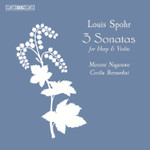|
Back
08/16/2018
“3 Sonatas for Harp & Violin”
Louis Spohr: Sonatas in D major, opus 113, in G major, opus 115, & in D major, opus 114
Masumi Nagasawa (harp), Cecilia Bernardini (violin)
Recording: Protestantse Kerk ‘t Woudt, Schipluiden, The Netherlands (October 2016) – 74’46
BIS Recordings # BIS-2302 SACD – Booklet in English, German and French

   
Instantly, this CD deserves a superior rating solely due to the artists’ emulation of technical merits and obligations musicales emphatically deemed by Louis Spohr. In a breath of historical re-enactment, the recording unfurls and replicates those effusive incantations outlined by violinist/harpist Louis Spohr and his first-wife, harpist, Dorette (née Scheidler.) While the annals of time transmogrified the single-action harp into the more dominant double-action harp, this story centers around the former at the turn of the 19th century and its suigeneris appeal.
So what’s the irresistible connection? It lies within Spohr’s fastidious dynamic detailing, heavily concentrating on the manner of how sound is generated and digested. Portamento, one of the most prominent distinctions on the CD, bears trademark sophistication that surface through Bernardini’s Camillo Camilli, Mantua 1743 violin. Tenderness suffuses the notes.
M. Nagasawa’s pearly visions opening the Sonata in G major aid in fortifying the flowing violin lines. The tables flip and flop: at times the harp spotlights, yet the violin occasionally dwells on center stage. Similarly, the inherent beauty of the single-action harp rests within its silvery-toned pronouncements. Trained on a multitude of harps (including the Japanese kugo), Masumi Nagasawa sustains poignancy and élégance éthérée of Spohr’s difficult assemblages that marvel the listener.
One of the best examples of refined nuances and impeccability is found within the Sonata in D major’s “Adagio’: we’re satiated by Mlle. Nagasawa’s detailing, replete with politely demurred tempo rubato whilst bathed amongst Mlle. Bernardini’s repartee.
The standout element of the Masumi Nagasawa/Cecilia Bernardini team is meticulousness: the duo dutifully honors those uncompromising and unconventional techniques mandated by the composer. Devotee Clive Brown, Professor Emeritus at the School of Music at University of Leeds, has made a painstakingly incisive journey into Louis Spohr’s wisdom, not only through personal research but through sizeable instruction involving harpist and violinist. Spohr summarized his music as “schöner Vortrag” (“beautiful performance”), and this issue clearly lives up to this tagline.
Mr. Brown’s write-up is fascinating. BIS Records couriers the music with organic groundings: if one is drawn to peripheral creaks and prods [of the seven pedal single-action harp and the violin – via a Dodd bow with fouetté technique and on-string staccato], this CD fits the bill. These unfiltered sounds are well-represented in the sprite “Allegro vivace” housed inside the Sonata in D major. Masumi Nagasawa reveals her own beautifications, an ironic tugging of raw energy dipping into sparkling steely plucks. Her monumental achievement yields genuine truth via a F.J. Naderman, Paris 1815, single-action pedal harp.
Furthermore, the ensuing second movement, “Potpourri”, a delicate brim of excerpted “thoughts” from The Magic Flute, appears to be superficially simple, yet the selection is physically complex. Louis Spohr’s characteristically delineated crescendos and decrescendos cleanly pronounce through M. Nagasawa’s decisive divisions of melodic and harmonic lines...this is one magical piece.
Louis Spohr’s compositions surrounding these two exquisite period instruments will stun the listener.
Christie Grimstad
|